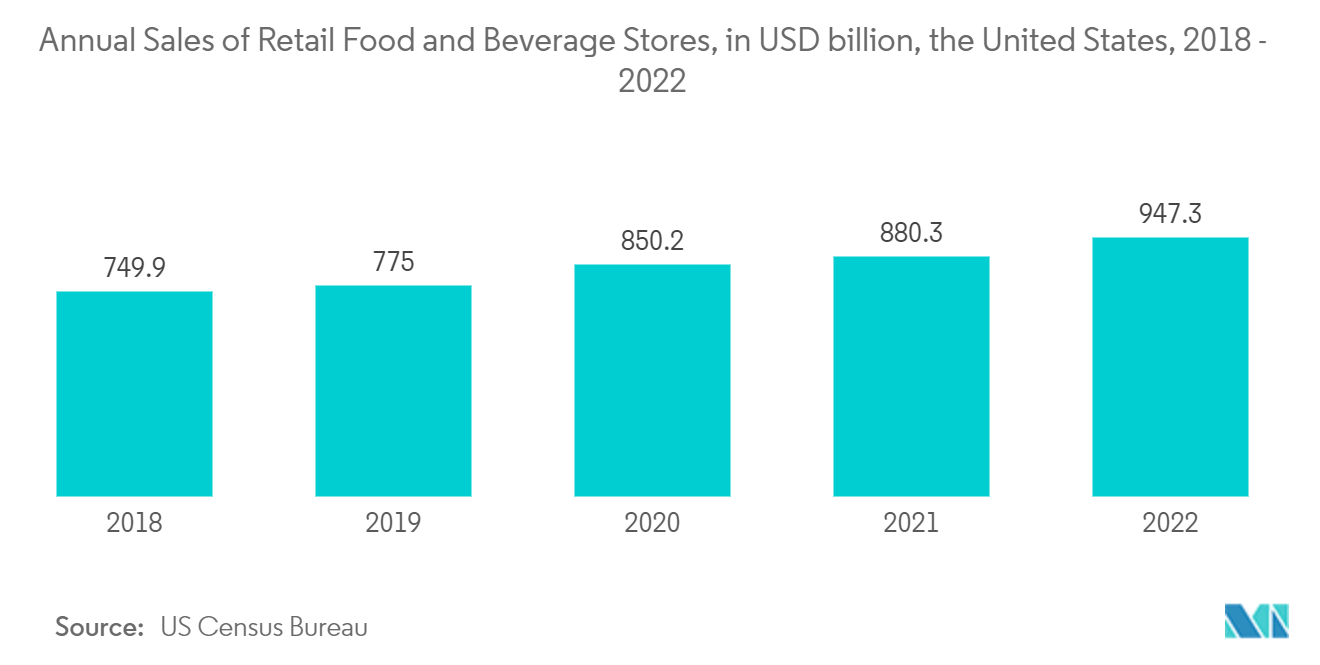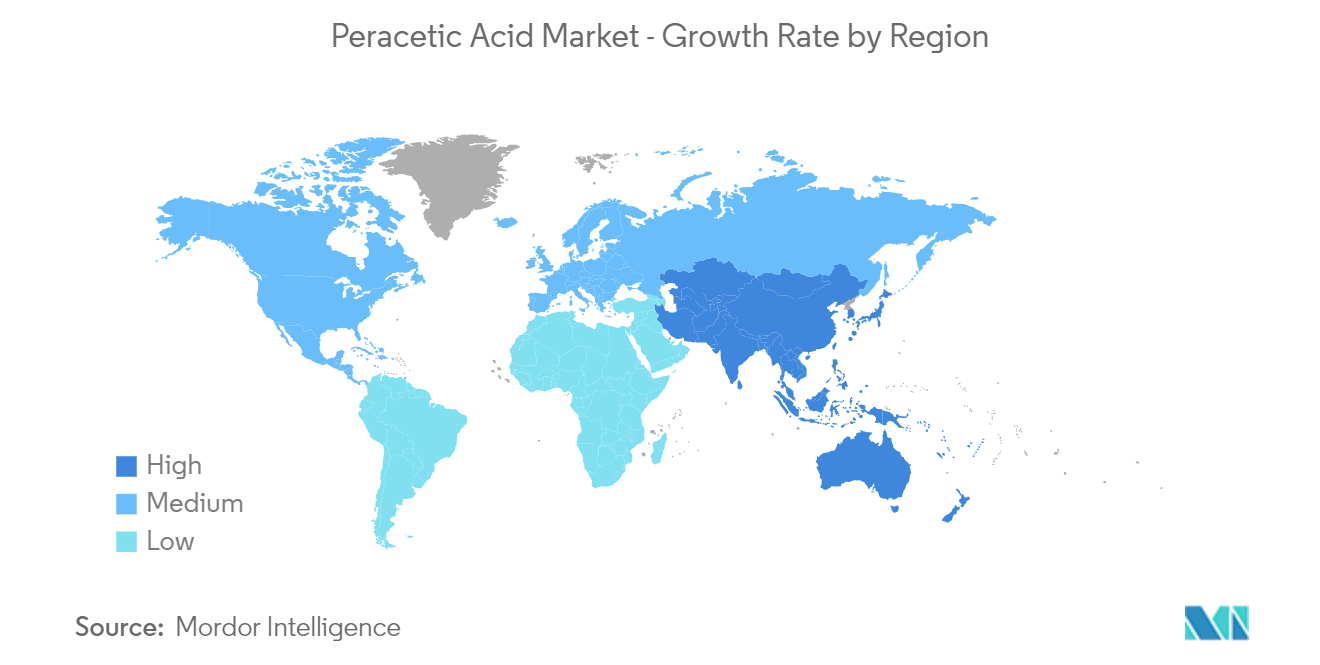Market Trends of Peracetic Acid Industry
Disinfectant Application to Dominate the Market
- Peracetic acid (PAA) is used as a disinfectant and cleanser in the food industry, in water treatment, and to prevent biofilm formation in the pulp industries.
- To maintain hygiene standards, peracetic acid is used as it is a broad-spectrum biocide and can be used in many industrial fields. It is effective against all types of microorganisms like bacteria, fungi, spores, and viruses, even at low concentrations and temperatures.
- Its capability to penetrate through the cell membrane helps it impart excellent and rapid antimicrobial effects. When PAA enters the cell, it irreversibly disrupts the enzyme system, which leads to microorganism destruction.
- PAA is used to disinfect food and beverage products. For instance, according to the US Census Bureau, in 2022, annual sales of retail food and beverage stores in the United States amounted to approximately USD 947 billion, which showed an increase of 7.65% compared with 2021. Therefore, an increase in the sales of food and beverage products is expected to create an upside demand for peracetic acid.
- PAA is applied to disinfect equipment, surfaces, tanks, pipes, and plastic bottles to protect the inside material from microorganism attacks along the production chain. It is also used to disinfect water treatment in textiles and medical devices.
- Another important use of peracetic acid as a disinfectant is in ballast water treatment. Ballast water is used to control ship trim, list, draught, stability, or stresses, and billions of tons of ballast water are discharged by ships every year. The International Maritime Organization requires ships to discharge ballast water only within specific discharge standards. To meet these standards, peracetic acid can be used in ballast water.
- In the animal health industry, PAA is used to disinfect surfaces to avoid livestock diseases. It is sprayed by mechanical sprayers or pressure washers to sanitize the system and eliminate the growth of baPAA is majorly used as a disinfectant in the food and beverage and water treatment industry. A rapidly growing population and greater urbanization globally have boosted processed food demand. More than 70% of food in developed countries is processed food. These products are generally packed in plastic containers which need disinfection. This is likely to boost disinfectants like PAA demand from the food and beverage industry.
- Further, several countries have made their wastewater treatment rules and regulations more stringent to meet the sustainable development goal and protect the environment. In North America, under the effluent guidelines, the Environmental Protection Agency (EPA) develops national standards for wastewater discharge. These standards are incorporated into the National Pollutant Discharge Elimination System (NPDES).
- In the European Union, it is mandatory for all member countries to follow the wastewater treatment directive mentioned in The Council Directive 91/271/EEC for urban wastewater treatment. If countries fail to comply with these regulations, they can receive court action and fines.
- Hence, the aforementioned factors are likely to increase disinfectant demand from various industries during the forecast period.

Asia-Pacific Region to Dominate the Market
- The Asia-Pacific region is expected to dominate the market for peracetic acid during the forecast period. In countries like China, India, and Japan, the demand for peracetic acid increased due to the increasing demand from the pharmaceutical, food, beverage, and chemical industries.
- In the Asia-Pacific region, China is the largest economy in terms of GDP. China's real GDP grew by 8.4% in 2021, primarily driven by consumer spending rebound post-pandemic. Furthermore, in 2022, as per the International Monetary Fund (IMF), the country's GDP is accounted to grow by 3.0%, whereas, in 2023, the IMF has forecasted that the GDP will grow by about 5.2%.
- In the food and beverage industry, peracetic acid is used as a food processing aid for antimicrobial intervention without adding odors, colors, or flavors to the end product. It is also used to sanitize and disinfect animal facilities.
- China is one of the largest consumers of food and beverages, with the food processing industry continuing to expand in view of the growing population and rising demand for healthy and tasty packaged foods. Some of the popular food products in the country include bakery products, beverages, and other nutritious food items, among others. For instance, according to the data from the Ministry of Industry and Information Technology, the country witnessed its beverage production increase 6 percent year-on-year, reaching 44.35 million tons during Q1 2023.
- Furthermore, according to the China National Light Industry Council, major food manufacturing companies with an annual turnover of over USD 2.8 million reported revenues of over USD 1.53 trillion in 2022. Compared to 2021, the total revenue registered a year-on-year growth of 5.6 percent, indicating strong growth in the food industry.
- According to Indian Paper Manufacturers Association (IPMA), exports of paper and paperboard from India jumped to around 80% in 2021-22, touching a record value of INR 13,963 crore (~USD 1,692.17 million). In addition, as per the report of the Pulp & Paper Research Institute (CPPRI), there are about 861 paper mills in India, out of which 526 are operational, with a total installed capacity of over 25 million tons in 2020-21. Thus, the demand for peracetic acid is expected to be high in the country during the forecast period.
- The Japanese food processing industry produces a wide range of foods, from traditional to processed food, for infants and elderly people. The food processing industry in the country is estimated to grow in the coming years, owing to the higher consumption of food and beverage products. The food and beverage industry in the country is driven by the rising demand for packaged food.
- Japan is the third-largest package food market in the world after the United States and China. According to Euromonitor, it is estimated that by 2025, the retail sales in the packaged food market in Japan are expected to reach USD 204.5 billion, a growth of 3.6% or USD 7 billion. This growth is attributed to the increase in the demand for the market studied.
- All such factors are likely to increase the demand for peracetic acid, which as a result, leads to its market growth over the forecasting period.

